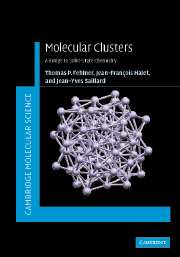Book contents
- Frontmatter
- Contents
- Preface
- 1 Introduction
- 2 Main-group clusters: geometric and electronic structure
- 3 Transition-metal clusters: geometric and electronic structure
- 4 Isolobal relationships between main-group and transition-metal fragments. Connections to organometallic chemistry
- 5 Main-group–transition-metal clusters
- 6 Transition to the solid state
- 7 From molecules to extended solids
- 8 Inter-conversion of clusters and solid-state materials
- Appendix: Fundamental concepts: a concise review
- Problem Answers
- References
- Index
Problem Answers
Published online by Cambridge University Press: 19 February 2010
- Frontmatter
- Contents
- Preface
- 1 Introduction
- 2 Main-group clusters: geometric and electronic structure
- 3 Transition-metal clusters: geometric and electronic structure
- 4 Isolobal relationships between main-group and transition-metal fragments. Connections to organometallic chemistry
- 5 Main-group–transition-metal clusters
- 6 Transition to the solid state
- 7 From molecules to extended solids
- 8 Inter-conversion of clusters and solid-state materials
- Appendix: Fundamental concepts: a concise review
- Problem Answers
- References
- Index
Summary
1. (a) Approach: Cr possesses six valence electrons, thus ligands must be chosen to supply 12 more to satisfy the 18-electron rule, e.g., six CO ligands; Mn possesses seven valence electrons, thus ligands need to supply 11, e.g., 5 CO + 1 H. (b) This problem requires recognition of the types of bonds in the molecule and which ones, if any, are unusual. The answer to part (a) suggests the Cr–CO bonds can be adequately described as two-center donor–acceptor bonds. The Cr–H–Cr with a two-coordinate H atom is clearly the unusual situation; hence, a fragmentation into two Cr(CO)5 fragments and an H–anion is appropriate. A Cr(CO)5 fragment is a 16-electron species with an empty orbital available to accept an electron pair. The H– anion possesses one filled orbital; hence, the three orbitals (two from the metal fragments and one from H) can be used to form one bonding, one non-bonding and one antibonding three-center orbital with the bonding combination containing the two available electrons.
2. S contributes four AOs and the six H atoms contribute six AOs for a total of ten leading to ten MOs. The central atom has functions of symmetry a1g (3s) and t1u (3p), whereas the six ligand functions have symmetry-adapted combinations of a1g (3s) and t1u, and eg just like an octahedral transition-metal complex. As shown below, interaction between the central atom and the ligands generates four bonding MOs plus their antibonding partners and two non-bonding orbitals having ligand character only for atotal of ten MOs.
- Type
- Chapter
- Information
- Molecular ClustersA Bridge to Solid-State Chemistry, pp. 349 - 368Publisher: Cambridge University PressPrint publication year: 2007



